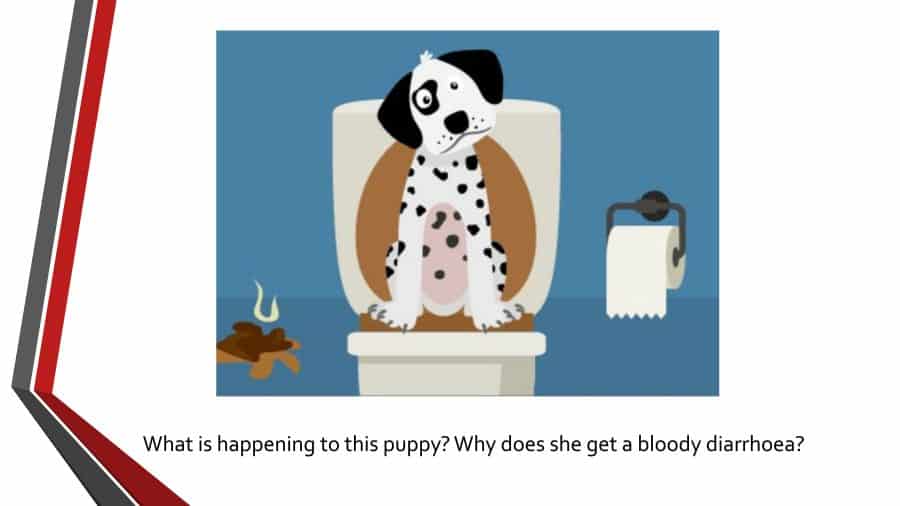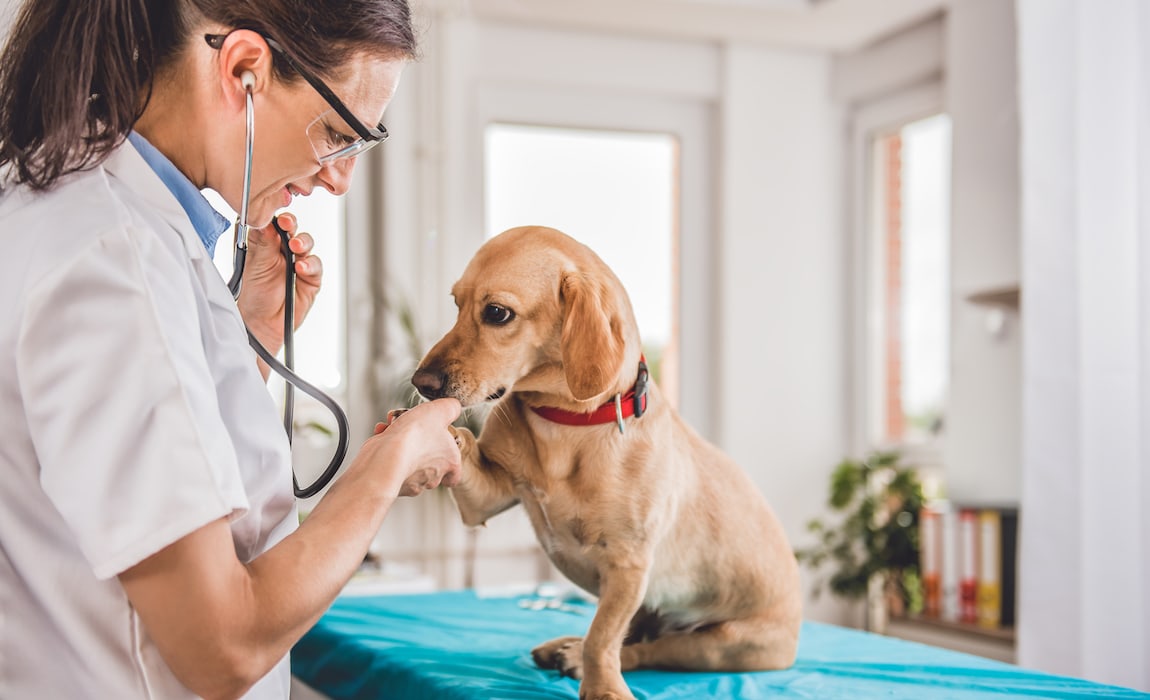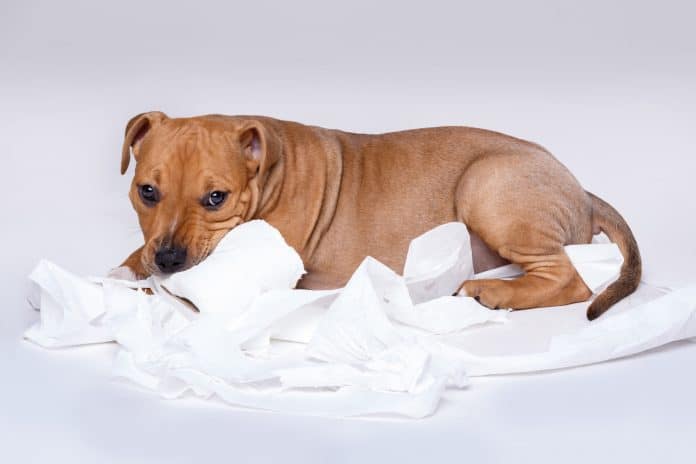When you first see blood in dog stool, it can be a bit scary. But don’t panic; call your veterinarian and fix an appointment to talk about this occurrence.
First, ensure whether the red color is the blood color or not. If it is not blood, then you have nothing to worry about.
If not blood, the red color can be due to food coloring, or lipstick or crayon coloring if your dog ate it. These won’t have a lasting negative effect.
You may link bloody stools with some serious illness. However, there are many minor and major causes leading to it.
This condition is a sign of another, underlying problem. When your vet diagnoses the issue properly, she can provide quick treatment.
It can be of great help to your vet if you have a stool sample or a picture of your dog’s stool. Also, check whether the bloody stool is hard or loose (similar to diarrhea).
Even though the sight of stool may be unpleasant, describing its appearance to your vet would save adequate time.
Table of Contents
Appearance of Blood in Dog Stool

The blood in stool of dog can look like:
- Bright red stripes
- A black color seen throughout the whole poop.
- Drops of blood falling from your dog’s bottom.
The bright red blood in dog stool comes from the lower digestive system, whereas the black color in poop suggests an upper digestive system problem.
Types of Blood in Dog Stool

There are two types of dog stool with blood: Hematochezia, and Melena.
Hematochezia is the term used in the medical sphere for the bright red color in a pet’s stool. The term Melena is used medically to mean dark red or black stools.
Stools With Bright Red Colored Blood
The blood with bright red color comes from the lower intestines, and most of the times from the rectum or colon. Causes of bright red blood in dog stools are:
- Illness of Virus and Bacteria – Dogs develop discomfort in their lower intestine passage. If you observe signs such as loose stools, loss of appetite, and vomiting, then a viral or bacterial infection has occurred.If not treated early, infections can lead to a condition called hemorrhagic gastroenteritis. This results in certain hospitalization. If you don’t act fast, Parvovirus can form. If left untreated, it leads to death.
- Parasites – They can commence bleeding in the lower intestinal passageway. Even dogs receiving regular medicines may become infected. Contact your vet immediately in the case of a parasitic problem.
- Foreign Objects – Dogs are likely to eat anything that comes in their hands. These non-food items can get placed in the intestinal passage causing strain and loose motions. Consequently, blood can begin showing its presence in the tract.
- Injury in the Rectum – When a sharp-edged item gets into the dog’s stomach, it can cut the lower intestine during elimination or digestion, causing bleeding.
- Allergies of food – If an ingredient causing allergy is consumed, inflammation can ensue. Consequently, this can cause damage to the passageway and bleeding. Avoid feeding your dog toxic food.
Stools with Dark Red or Black Colored Blood
Dark Red or Black Colored blood comes from the upper intestine. This condition can be caused by:
- Disorders of Blood Clotting – This can happen due to many reasons, including the consumption of rodent poison. In these ailments, the body becomes incapable of making the blood clot and relentless bleeding can result.
- Surgery related issues – If your pet has undergone a recent surgery, and black stools start appearing, this could be a sign of bleeding.
- Cancer – When tumors bleed, it may cause dark stools to form.
- Swallowing Blood – If your dog has swallowed blood from an injured area in the mouth or elsewhere, bloody stool might result.
When bleeding with stool is coexistent with diarrhea, lethargy, puking, loss of appetite, urinal bleeding, weakness, and breathing difficulty, vet care should be immediately called for.
So, now you might have gotten familiar with the answer to what causes blood in dog stool? Now, let’s dive into how the mucus and blood in dog stool are diagnosed and treated.
Diagnosis of Blood in Dog Stool

Once you bring your pet to the veterinarian, she will conduct an in-depth examination to assess your dog’s overall health and look for symptoms of any illness.
Moreover, she will check the dog’s stool for parasites with the process of fecal floatation. Parasites are not easy to be seen, as they live within the intestine.
For this reason, fecal floatation is performed that would enable the vet to ascertain if the dog has intestinal parasites.
Parasites that result in mucus and blood in dog stool include Giardia, Hookworms, and Whipworms.
The veterinarian may also want to assess the presence or absence of viral illnesses, such as parvovirus. She may also do blood work screening for checking other illnesses.
The vet may perform x-ray radiography or ultrasound imaging if she fears the presence of a foreign object inside the body.
Treatment of Blood in Dog Stool

If the vet concludes that the blood in stool of dog is because of a certain source, she will treat the condition accordingly:
- If the dog stool blood and mucus are the outcome of eating bad food, then the vet may suggest a special diet and medication for a few days or weeks.
- If parasites are the source, then the vet will authorize deworming medications for your dog and will guide you about safely cleaning up the dog’s surroundings to stop further infections.
- Parvovirus will certainly necessitate hospitalization, antibiotics for secondary infections, and intravenous liquids.
- If foreign objects inside the dog’s body are discovered, immediate surgery will be asked to be performed.
Finally, your vet will ascertain the best treatment possible depending on your dog’s diagnosis and condition.
If you liked reading the article and thought you gained some useful info, keep browsing the website for further similar articles.
Don’t forget to comment your valuable knowledge regarding this topic.
Happy Petting to You Guys!













[…] Abdominal pain, Loss of appetite, Bloody stool, Lethargy, […]
[…] You should immediately halt the provision of oranges when you observe that your pooch is behaving unusually with episodes of vomiting and diarrhea. […]